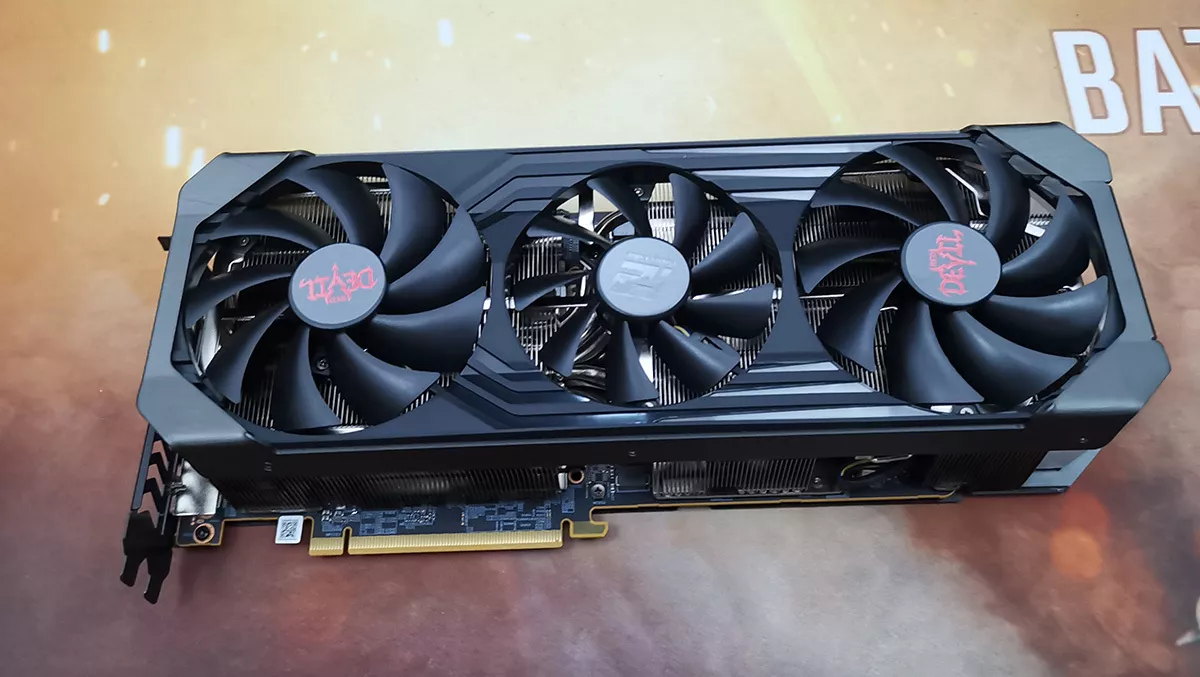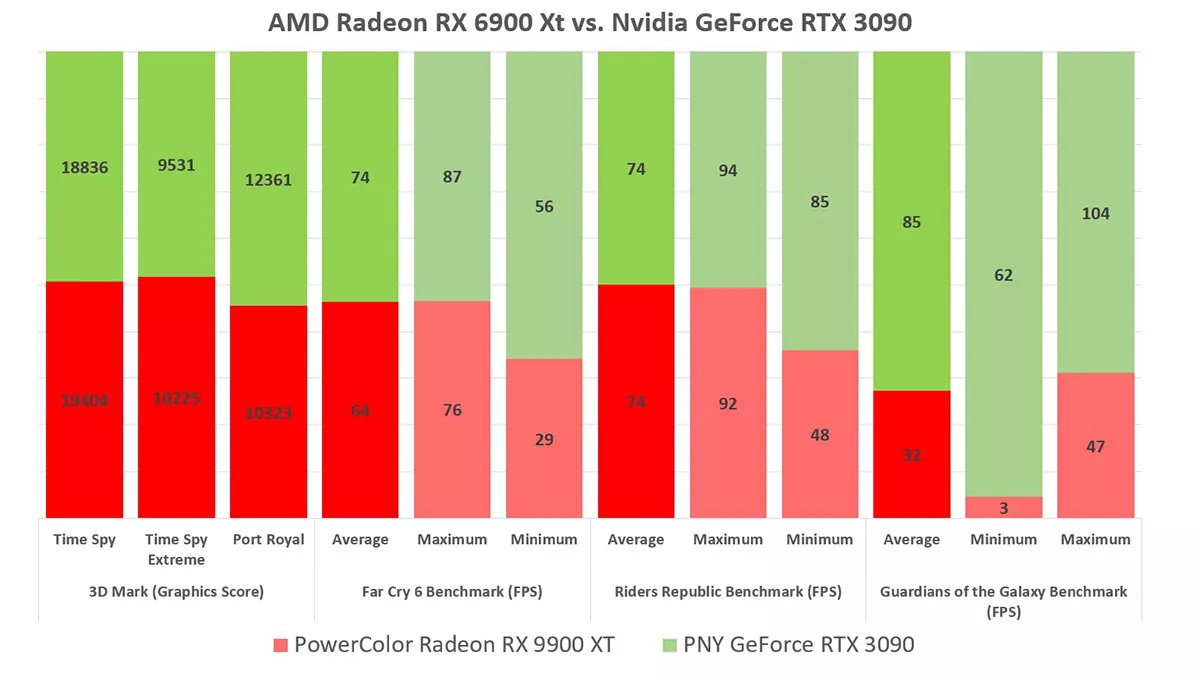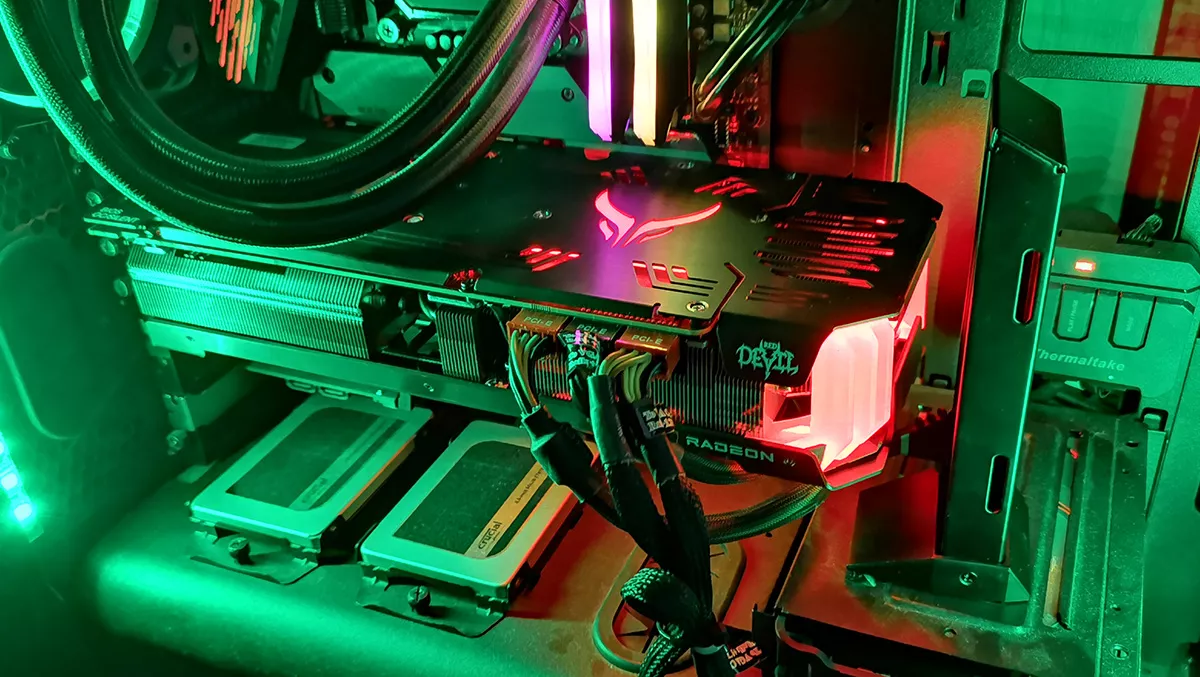
Hands-on review: PowerColor Red Devil AMD Radeon RX 6900 XT Ultimate
The rivalry between AMD's Team Red and Nvidia's Team Green, when it comes to graphics cards, is not quite as ferocious as that of Team Red and Intel's Team Blue with CPUs. This is mainly because whilst AMD's Ryzen CPUs represent a cheap and just as powerful (in some cases more powerful) alternative to Intel's chips, AMD's Radeon graphics cards have been playing catchup to Nvidia's GPU for years.
AMD's Radeon RX 6000 XT-series GPUs have been snapping at the heels of the Nvidia GeForce RTX 3000 cards. Whilst a bit of competition is nice, Nvidia has been waving their extortionately-priced beefy graphical unit, the GeForce GTX 3090, at everything that AMD has to offer. With the GTX 3090, which is not a consumer GPU (whispering: but it is, really), Nvidia has retained the crown of the most powerful gaming graphics card since its release almost a year ago.
Most of this geeky willy-waving has been, for the most part, academic. This is because nobody has been able to buy a decent GPU without re-mortgaging their house due to COVID-19, crypto mining, scalping, component shortages, etc.
AMD's Radeon RX 6900 XT was originally intended to take on the RTX 3080. I'd heard that it was a powerhouse, but not tested one for myself.
AMD sent over a PowerColor Red Devil Radeon RX 6900 XT Ultimate to test. This version of AMD's flagship graphics card features a beefy three-fan cooling arrangement on top of a chunky arrangement of heat pipes and cooling fins. It has a metal backplate to protect the board itself.
The card has three DisplayPort sockets and one HDMI. It also has a dual BIOS, one for silent running and the other for overclocking. The OC setting is still very quiet, with the fans operating almost silently.
As is standard with these cards, the PowerColor Red Devil Radeon RX 6900 XT has 16GB of dedicated GDDR6. This puts it way ahead of the 10GB Nvidia's Geforce RTX 3080 GPUs, but less than the RTX 3090s 24GB. 16GB is, however, more than enough for 99% of games and applications.

Powercolor boasts that the card contains specially binned GPUs for better performance. In the OC setting, the GPU is clocked at 2235MHz in game mode, boosting to 2425MHz. These are higher than those typical of RX 6900 XT cards. Using AMD's Adrenalin software, these frequencies could be increased further. I did notice that the manufacture recommends a 900W power supply for the card.
The card measures 320mm x 135mm x 62mm. It's a good 100mm longer than an ATX motherboard. It's a big beasty. It's longer than RX 6600 XT currently in service in the test rig. And, considering that GPU only just fits in the case, the 6900 was never fitting. Wondering why I built a test rig in such a tiny case (there was a reason, but I can't recall), I realised that I had no alternative but to dismantle my main gaming PC to test the Radeon powerhouse properly. This is a PC that usually houses a PNY GeForce RTX 3090. I could do a direct comparison between AMD's flagship GPU and that of Nvidia. The machine is equipped with an Intel i9 10900K CPU making it quite the gaming PC.

Installation was a breeze, and the three DisplayPort sockets plus one HDMI were more than enough for the two monitors connected to the PC. The Radeon Adrenalin software installed easily, updating the drivers without issue. Probably the easiest GPU swap-out I've done in a while.
The Radeon RX 6900 XT is not only bigger than my PNY RTX 3090, but it also needs an extra 8-pin plug from the power supply, that's 3x 8-pin power sockets. PowerColor is not messing about with powering this unit. Interestingly, the kit also comes with a plastic support piece to reduce the stress of the weighty card on the PCIe slot.
Installed, the RX 6900 XT looks pretty spectacular with its red RGB lighting. Not only is the Red Devil logo lit up on the top, but there's also a sizable bit of red lighting on the end of the GPU that makes it look like it was ripped from hell itself!
3D Mark's regular tests, TimeSpy and Timespy Extreme, as artificial as they may be, showed the RX 6900 XT beating my RTX 3090. For the Timespy test, the AMD card had a graphics score of 19404 against Nvidia's 18836. The Timespy Extreme test was equally impressive, with AMD the winner once more with a graphics score of 10225 vs Nvidia's 9531. It was only with the Port Royal ray tracing benchmark that the RTX 3090's score of 12381 beat the RX 6900 XT's 10323.
As well as testing both cards one after the other with 3D Mark, I also ran the internal benchmarks for Far Cry 6, Riders Republic, and Marvel's Guardians of the Galaxy. To sort the men from the boys, the games were all run at the ultra settings with DLSS/FidelityFX Super Resolution as available. The resolution was set at 4K with HDR switched on. V-Sync switched off, and Freesync/G-Sync enabled. The monitor refresh was set to 144hz.
For the Far Cry 6 test, the RX 6900 XT achieved an average frame-per-second of 64, a minimum of 29, and a max of 76. This is with everything maxed out and ray tracing on. The RTX 3090 attained an average of 74 fps with a minimum of 56 and a max of 87. That's a 10 fps lead for Nvidia's GPU, likely down to the card's better ray-tracing capabilities.
The recently released Riders Republic, another Ubisoft game with a good build-in and exportable benchmark, was next up. For this test, both the RX 6900 XT and RTX 3090 were neck and neck with an average of 74 frames per second.
For the third test, Marvel's Guardians of the Galaxy, The Radeon card scored 30 frames per second in the benchmark test against the reported 85 fps for the RTX 3090 card. This could again be down to the Nvidia GPU's better ray-tracing performance, but it would have been nice to have investigated further, but unfortunately, I ran out of time.
As a real-world test, I also played a bit of Microsoft Flight Simulator 2020, flying an F-15 Tomcat over Auckland. Again, in 4K HDR with ultra settings, the RX 6900 XT netted an impressive and consistent 40 fps, only just beaten by the RTX 3090 running at 47 fps. MSFS is a resource-hungry game, so to see 40 frames per second with everything maxed out in 4K HDR is pretty impressive. Being a sim, it's still very playable at that performance level. Of course, turning a few settings down should boost the frames a bit.

Whilst the RX 6900 XT may not have the chops of Nvidia's RTX 3090 when it comes to deep learning super-sampling and real-time ray-tracing, it can still hold its own. As far as I'm concerned, the PowerColor Red Devil RX 6900 XT Ultimate is on par, performance-wise, with the Nvidia RTX 3090 for games. It's also a good $500 cheaper. But, at AU$2399/NZ$2875, is it really worth buying over AMD's Radeon RX 6800 XT and saving between $500-$1000? Just as with the GeForce RTX 3090 and RTX 3080, probably not.
Extravagant? Yes. Expensive? Maybe. Powerful? Definitely. But, if you do want the best graphics card that AMD has to offer, you are going to go for the RX 6900 XT, especially this PowerColor Red Devil RX 6900 XT Ultimate.


